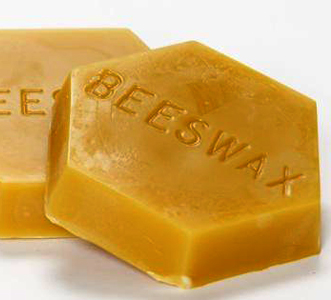
BEE WAX
Honeybees are the only creatures that make their own home construction materials. When they need to create a place to raise their young or to store food, worker female bees make honeycomb. Beeswax is a tough wax formed from a mixture of several compounds including: hydrocarbons, monoesters, diesters, triesters , hydroxy monoesters, hydroxy polyesters, acid esters, acid polyesters, free acids, free alcohols, and other unidentified substances.
How Bees Make Beeswax
Honeybees ingest honey to make beeswax. It takes approximately 7 kg of honey to produce 1 kg of wax. Once honey is ingested, the bees hang inside the colony for 24 hours while their bodies convert the honey into wax. The wax is secreted out of eight glands on the underside of the bee's abdomen. When the wax leaves the bee's body and comes in contact with the air, it causes the wax to solidify into dinner-plate shaped flakes. The bees then grab these wax plates with their legs, bring them up to their mandibles, and chew them to soften the wax. Then they carefully mold the wax into the perfect honeycomb structure.
How to prepare bee wax?
After removing honey the new breads must boil along with water and remove all other grains with water and allow to cool. Bee wax will come upto the water and keep it in a airtight object.
History of Beeswax
When beekeepers used to extract honey, they would use cheesecloth the press the honey out of the beeswax honeycomb. Left with all this extra wax, they would then use their uneventful winter months to create candles out of this versatile material.
How Beeswax Cleans the Air
Burning beeswax produces negative ions that circulate in the room and attract pollutants, in much the same way that a magnet attracts iron fillings. Dust, odours, moulds, bacteria, viruses, and other toxins are captured and neutralized. Beeswax actually cleans your air. However, you still have to vacuum your house.
Burning beeswax produces negative ions that circulate in the room and attract pollutants, thus actually cleaning the air. You can burn beeswax in an unventilated room without fear of pollution. In fact, many people report that burning a candle in the bedroom for 30 minutes or so before falling asleep produces a more restful sleep.
Paraffin, on the other hand, is a petroleum waste product, made from the sludge left over from the gasoline and petrochemical refining process. Paraffin produces no negative ions and so adds to the pollutants in your home. People with respiratory problems should not use paraffin candles, nor should people who do not want to develop such problems.
Burning paraffin produces toxic combustion by-products, many of which are known to be carcinogens. Breathing the fumes from burning paraffin candles is essentually the same as breathing the exhaust fumes from a diesel engine.
Caring for & Burning Beeswax Candles
Beeswax candles burn just as long, if not longer, than paraffin candles. They are brighter and cleaner-burning.Never leave a burning candle unattended. Burn on a flat surface. Consider placing on a candle plate in case of drips. If the candle starts to get "dusty" looking, that is simply the honey in the beeswax coming to the surface. Simply polish with a damp cloth to keep your candle looking bright and new.
Uses for Beeswax
Beeswax isn't just used to make candles! Also it use to make cosmetics, soap and Wax surfboards, Polish furniture, Lubricate zippers, Wax your mustache, Make a work of art.
Beewax chemistry
Beeswax is the major component of honeycomb. It is secreted in tiny flakes from the underside of the abdomens of worker bees, and moulded into honeycomb. Beeswax is soft to brittle, with a specific gravity of about 0.95 and a melting point of over 60 degree celsius, and consists of at least 284 different compounds, mainly a variety of long-chain alkanes, acids, esters, polyesters and hydroxy esters.
These include free cerotic acid (hexacosanoic acid, CH3(CH2)14COOH), the ester of cerotic acid and triacontanol.(CH3(CH2)29OH), myricin (myricyl palmitate, CH3(CH2)14COO(CH2)12CH3), and hentriacontane, CH3(CH2)29CH3. Hentriacontane comprises 8-9% of beeswax, and its stability and impermeability to water contribute to the role it plays as a structural component. Although insoluble in water, beeswax can be dissolved in solvents such as carbon tetrachloride, chloroform, or warm ether. The exact composition of beeswax varies with location.
Preparing beewax cream
Boil pure bee wax and virgin coconut oil in the ratio 1:4 and add 1-2 drops of natural vanilla essence when it lukewarm. It is useful for all winter related skin problems and very good Moisturiser.
Why we prefer beewax cream
Avoid petrolium jelly, parrafine as well as costumes to stay healthy yourself and next generation.Bisphenol A (BPA) is an environmental estrogen found in many plastics that stimulates the proliferation of human breast cancer MCF-7 cells. As you know both plastic and petrolium jelly are the by products of petrolium.
A study shows in childrens and their family who have lukemia ( blood cancer), their mothers were used alot of costumes even they were carrying and feeding. Then, we can understand how plastic or pertolium products badly affect us and our next generation.